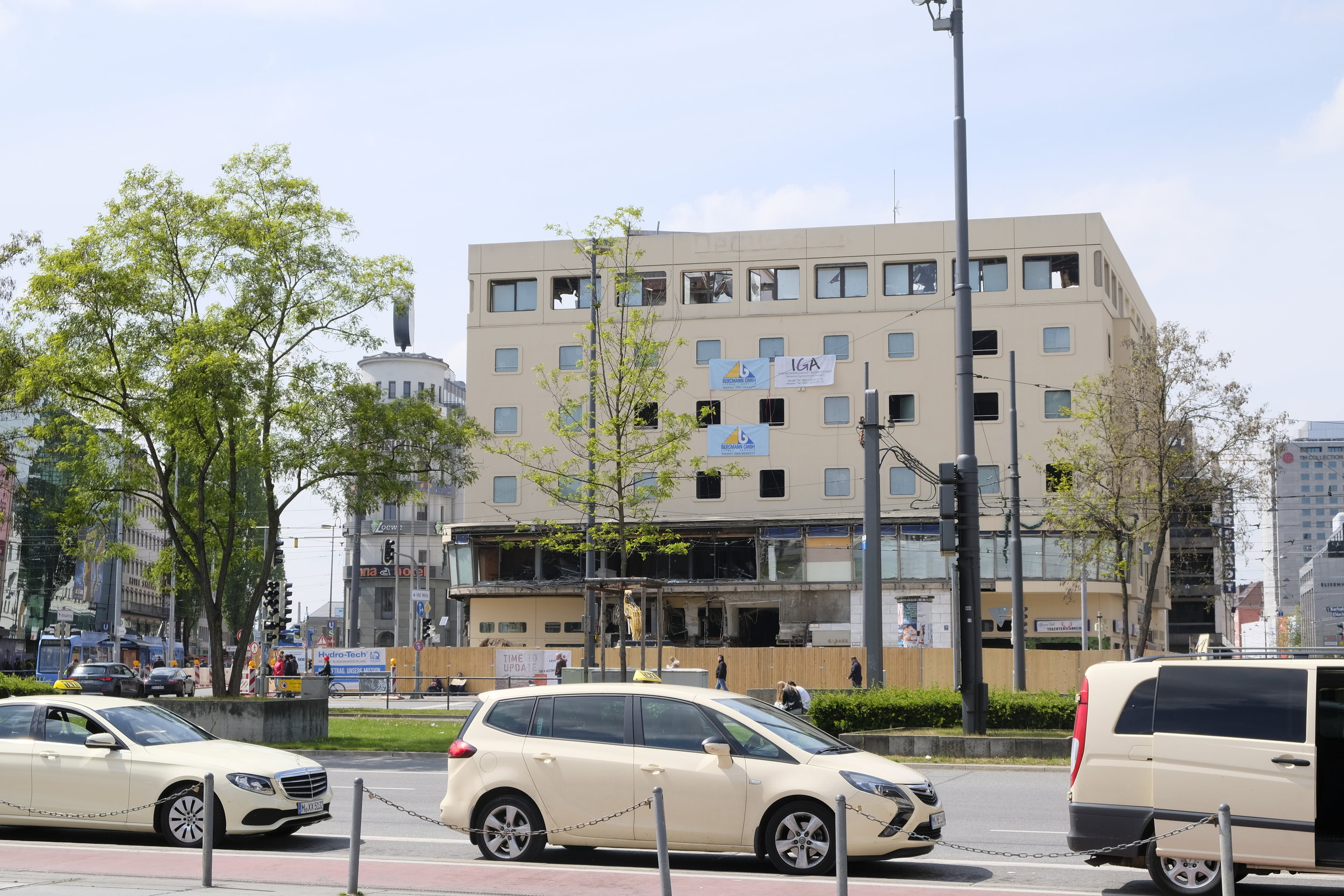Sonja Haider (photo: Hartmut Keitel)
From working on the Munich Börse and the mighty London Stock Exchange to working for green groups, interspersed by a stint as an interior designer, Sonja Haider brings a varied background to her role as an ödp representative on the Munich City Council. And her most recent project, the European Green Capital award, has the potential to transform her home city.
‘1.6 billion euros for new cycle pathways,’ reads the headline on the Süddeutsche Zeitung website in mid-December. The city council clearly wants to show the people of Munich that it’s taking the issue of cycling in the city seriously – the 1.6 billion euros would ensure that a cycle network of around 450 kilometres would be “built or extended”.
Considering where the city was a year ago, few would argue that this is anything other than a mightily impressive commitment.
Some weeks earlier, I had entered Munich’s Gothic town hall, home to the city council, to speak to Sonja Haider of the ödp, who is one of three of the eco-focused party’s representatives on the city council. The ödp (Ökologisch-Demokratischen Partei) translates as the Ecological Democratic Party, roughly a slightly more conservative ecological party than the much better-known Greens. While it’s not always clear where the overlaps and differences between the parties are, they both have a commitment to massively improving Munich’s sustainable travel options, including the aforementioned cycle network.
Successful citizens’ petition
On 15 October this year, the city council announced its first plans of how it would begin to implement a citizens’ petition to create a cycle path around the Altstadt, the Old City. Months earlier, Munich citizens had voted overwhelmingly in favour of not only this but also another ‘Radentscheid’ (cycling petition), which aims to build a comprehensive city cycle network worthy of the description – instead of the pathetic patchwork of cycleways it currently has. Munich’s notion of being a world-class cycle city, summed up in ‘Radlhauptstadt München’ (Cycling Capital Munich), was beyond parody – more so when compared to the likes to Amsterdam and Copenhagen.
Haider is spokesperson for both petitions and one of her focuses as a city councillor is sustainable transport. When the city announced that it would go forward with the first phase of the Altstadt cycle ring, she was quoted in local newspapers as saying she was, ‘… very excited that a first detailed plan had already been drawn up’. Her positivity with the news was still palpable when I interview her weeks later, simply because the city is finally starting to act, finally understanding that it ‘could do a lot better,’ as she puts it.
Munich is a city that likes to promote itself as up there with the likes of Amsterdam and Copenhagen, open, tolerant and ahead of the game when it comes to sustainability. At a stretch, one could argue that there is a kernel of truth to it. As the capital of one of Europe’s most affluent regions, Bavaria, and a city with huge wealth and no little influence, it could – should – be genuinely matching any city in the European Union in terms of sustainable living. The truth is, it doesn’t.
Munich Rathaus, the City Hall, facing Marienplatz
Stocks, shares and interior design
Haider’s background is interesting, formed in the banking sector, as a trader, first in her native Munich, then London in the early 1990s, in those early years after the Big Bang. She grew disillusioned with banking, leading to some soul searching, summed up in the question, ‘What the hell am I doing?’ Her answer eventually took her back to Munich to take on something she hoped would be more creative, training to be an interior designer. ‘But I discovered that though interior design is nice, it’s not more creative than banking,’ she says. ‘I then had an “aha! moment”, where I thought: “This is not what I want to do: glossy reports, nice photos and nice stands at a booth at a fair.” I like being creative but [as with banking] there was some kind of meaning missing.’
Her ’aha’ moment took her to the environmental movement, starting with Green City, an organisation a few green enthusiasts had started back in 1990, which has subsequently grown to become one of the most important groups pushing Munich towards a much more sustainable future. ‘I was the Finance Board member and I did book keeping. I worked for a lot of NGOs and very often I did the finance stuff. At Green City I also did a fundraising seminar for two years to understand how to get more funding possibilities.’
Despite the good works and the progress Green City made, the truth is that Munich is nowhere near its potential as an environmentally friendly city. Taking into consideration the relative wealth of the city, with its highly educated population and that it has had Green politicians on its city council for years, the city has been at best lethargic in pursuing any real green transformation. As Andreas Schuster from Green City alluded to me in this interview in summer 2019, the title the city gave itself of ‘Radlhauptstadt München’ was dropped after eight years … because it was demonstrably not true. And there seemed no prospect of it becoming true.
The start of a transformation
Haider, like Schuster, has been a persistent voice in the quest for Munich creating a genuine integrated cycling network. ‘Yes, I really do think we could do a lot better,’ she says. ‘But the answer as to why this hasn't happened in recent years is I think because people were happy and confident [with the state of the city] and no one wanted to change much.’ Haider does not say it, but some would argue that the lack of climate action is also partly down to Munich’s unique role as a bastion of the left-of-centre SPD in a heavily conservative CSU-dominated Bavaria. The Munich SPD might have been in power in the Rathaus for most of the last seven decades, in recent times often alongside the Greens, but there has always been an accompanying stultifying conservative stream to the way it operates.
This, however, appears to be changing – albeit on the back of the popular acceptance of the climate emergency, manifested in 2019 by regular FridaysForFuture, Extinction Rebellion and other demos in Munich, and the Greta Thumberg phenomenon. The upshot is that it now looks like Haider’s long-hoped for transformation could, finally, happen. And she’s delighted. ‘We’ve now got detailed plans, not just drafts,’ she says. ‘Previously, councillors and planners may have wanted to make changes but were held back … Now I have the feeling that people in authority are already very much in our favour ... Now they say they would like to push as many projects through as possible.’
The announcement of the colossal 1.6 billion euros to transform the cycle network, alongside experiments that have taken parking places away from a select few Munich streets, or restricted vehicle use on others, seems evidence that Munich is finally taking its responsibilities for sustainable travel seriously. The jury, however, is still very much out and campaigners are keeping up the pressure.
European Green Capital award
Towards the end of the interview, I ask Haider if there is any one single policy she most wishes she could get through the city council. ‘Yes, I want Munich to apply to be the Green Capital of Europe.’ It makes perfect sense. Munich is a capital used to applying for and hosting major competitions and events. And it’s pretty good at it. The nature of the application process alone would push Munich towards planning a radical transformation of the city’s green credentials – simply because to become the European Green Capital involves a whole host of criteria that need to be implemented and verified. Winning should set in motion that transformation.
It appears an inspired idea, and it is one Haider presents to the city council in November 2019. The idea is to apply for the 2023 award, and if not successful on this first attempt, to use it as a learning curve to win the one immediately afterwards. In a press release, she writes:
‘I particularly like the fact that the prize is not just a few glossy brochures – it demands a lot from the city when it comes to environmental protection. I also see great potential in the possibility of involving companies and citizens in the measures. Only together can the major environmental problems be solved.’
Just before finishing this article I see her again, this time in Pasing, where she’s canvassing, and handing out organic apples to passers-by, ahead of next year’s city-wide local elections. She’s optimistic that the city is finally heading in the right direction. She talks passionately about the success of the Radentscheid, and the building of the city’s cycle network. And she’s determined to put the European Green Capital award at the forefront of the agenda. It’s one of the best ways, she thinks, to ensure a long-lasting and fundamental transformation of her city in terms of sustainable living.
-
December 2019
- Dec 16, 2019 ÖDP's Sonja Haider interview: sustainable Munich & European Green Capital Award Dec 16, 2019
-
October 2019
- Oct 16, 2019 Munich city council reveals first plans for cycle path round Altstadt Oct 16, 2019
-
August 2019
- Aug 30, 2019 Let the train take the strain (out of travel) Aug 30, 2019
-
July 2019
- Jul 24, 2019 A coal-free Munich by 2020? Jul 24, 2019
- Jul 17, 2019 Munich CSU and SPD overturn 2022 coal referendum result Jul 17, 2019
- Jul 15, 2019 Extinction Rebellion rebel in Munich Jul 15, 2019
- Jul 9, 2019 SPD and Greens need to deliver on Munich cycling transformation Jul 9, 2019
-
June 2019
- Jun 24, 2019 Munich's historic old city petition hits target for referendum Jun 24, 2019
- Jun 24, 2019 Munich, cycling backwater to cycling capital? Jun 24, 2019
-
May 2019
- May 8, 2019 Munich modernises but is it modernisation without joined-up thinking? May 8, 2019
- May 5, 2019 Munich: carbon neutral or net zero? May 5, 2019
- May 3, 2019 Munich also needs to declare a climate emergency – now May 3, 2019
-
April 2019
- Apr 20, 2019 Extinction Rebellion in pictures Apr 20, 2019
- Apr 20, 2019 Extinction Rebellion comes to Munich Apr 20, 2019
- Apr 17, 2019 Munich aims to sign up cyclists Apr 17, 2019
- Apr 17, 2019 Munich Green Apr 17, 2019















































